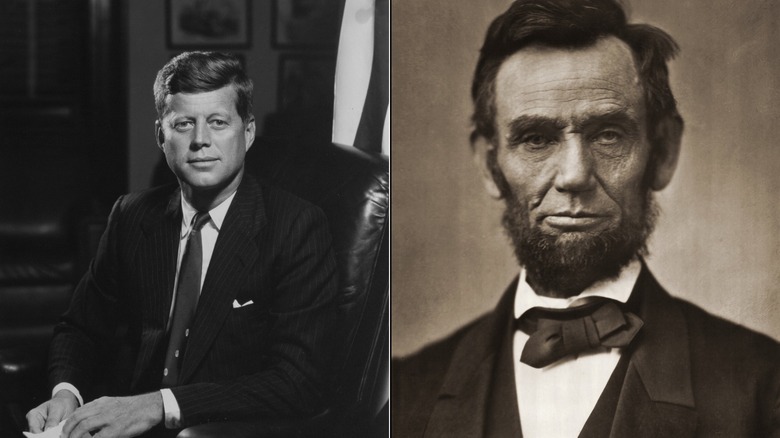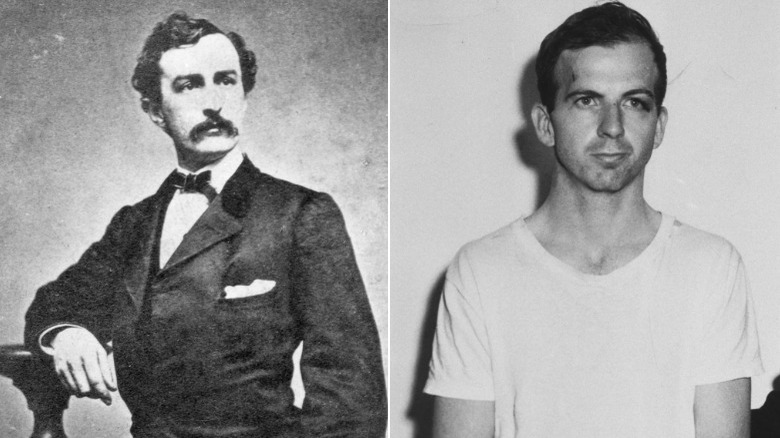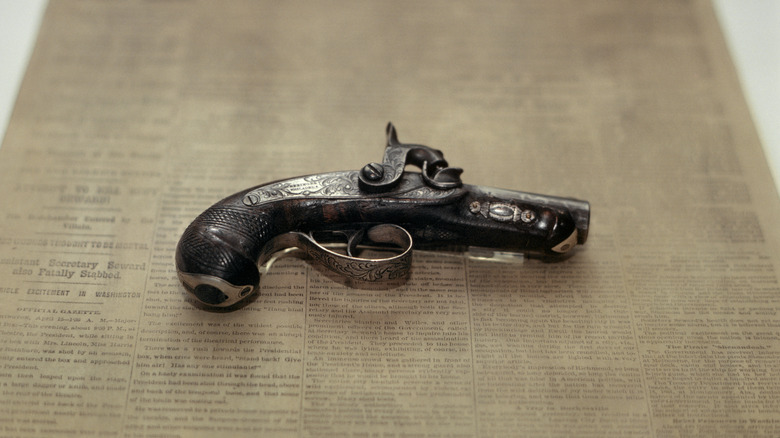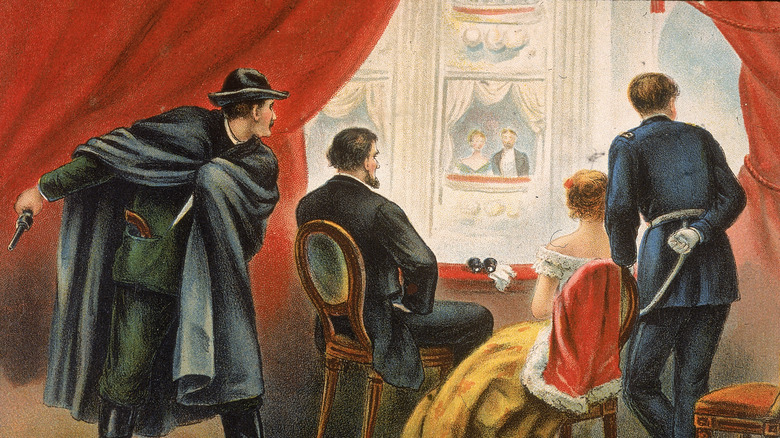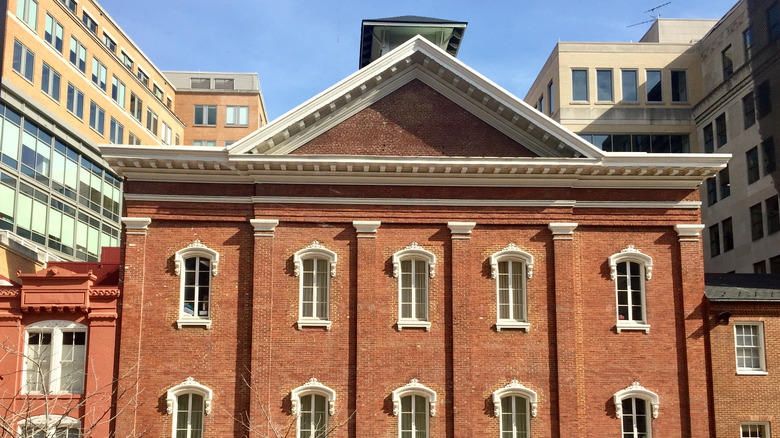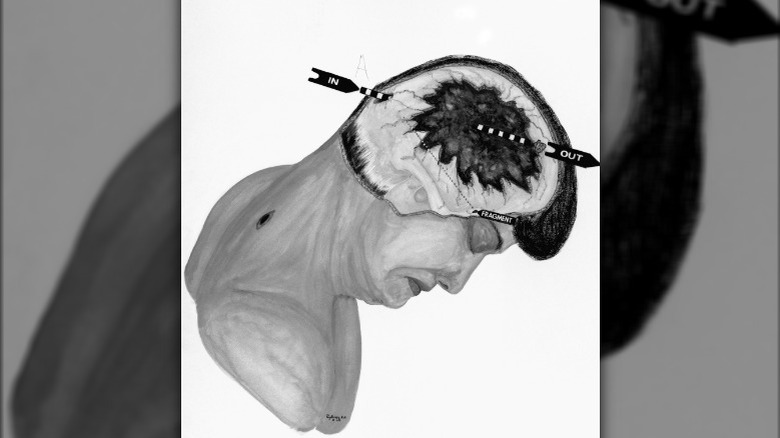The Most Chilling Connections Between JFK And Lincoln's Assassinations
Given the nature of politics and power, it's no surprise that assassination is commonplace, regardless of where in the world you look. Over the years, hundreds of leaders and political figures have been killed in murderous plots that changed the course of history. And while developed countries like the United States see less, there have still been many attempts to execute the powerful — namely, presidents. But only four schemes were successful — the killings of James A. Garfield, William McKinley, Abraham Lincoln, and John F. Kennedy. Those last two, in particular, share some chilling connections.
It's not surprising that you'd find ties and similarities across assassinations, given that the end goal is always the same: killing someone. But some of the links between the JFK and Abraham Lincoln hits are particularly eerie. Here are the most chilling connections between the two incidents.
A string of similar names and numbers
Abraham Lincoln died on April 15, 1865, after John Wilkes Booth shot him in the head the night before at Ford's Theatre in Washington, D.C. Booth put a bullet in his head with a 44-caliber pistol. Fast forward to November 22, 1963, and John Fitzgerald Kennedy was gunned down by Lee Harvey Oswald, who used a rifle with a telescopic sight. Both assassins have 15 letters in their names, and both are most commonly referred to by their first, middle, and last names. It should be noted, however, that Slate suggested in the case of Oswald, it was the press that began referring to him by his three names.
Both of the men the assailants killed — JFK and Lincoln — began their congressional careers in a '46 year — Lincoln in 1946, and Kennedy in 1946. When each ultimately won the presidential election before taking the White House, it was in a '60 year each time — Lincoln in 1860, and JFK in 1960. After their deaths, both presidents were succeeded by second-in-commands with the same surnames — Andrew Johnson and Lyndon B. Johnson.
Both assassins were killed with a Colt revolver - with one shot
Both John Wilkes Booth and Lee Harvey Oswald didn't live long after carrying out their notorious plots. Oswald was killed by Jack Ruby on live television on November 24, 1963 — two days after he assassinated John F. Kennedy. Meanwhile, Booth fled Ford's Theatre after murdering Abraham Lincoln, and he met his end 11 days later on April 26, 1865, after they closed in on the Virginia farm he was hiding out in.
Booth was killed by Army Sergeant Boston Corbett, a Union soldier, who shot him once with a Colt revolver. Oswald, too, was killed by a single bullet from Ruby's Colt revolver. Interestingly, some reports suggest Booth might have died by suicide. At the time of his death, he was carrying two Colt revolvers and a Spencer repeating carbine, which means if he took his own life, he likely used — you guessed it — a Colt revolver.
Both presidents were killed in the same manner, in similar situations
It was the bullet that hit John F. Kennedy in the back of the head that ultimately killed him. Abraham Lincoln, too, was killed by a single shot to the back of the head. The Warren Report concluded that the bullet that killed JFK "entered in the right rear of the head near the cowlick area and exited from the right side of the head," causing irreparable damage to the right side of his brain. According to the National Park Service, the bullet that killed Lincoln entered the back of his head "about an inch to the left of the medial line of the skull and at the level of his ear, traveled diagonally through his brain, and lodged behind the orbit of his right eye."
Both were killed on the Friday before a major holiday with their wives next to them. Lincoln was assassinated on Good Friday, two days before Easter Sunday, and JFK was murdered six days before Thanksgiving. They were also each seated beside their wives, Mary Todd Lincoln and Jacqueline Kennedy.
Both assassins did the deed at their workplace
John Wilkes Booth was employed as an actor at Ford's Theatre, where he shot Abraham Lincoln dead. He knew its owners, John and Harry Ford, personally, and they even let him use the building as he wished. Actors and stage employees knew who he was, and he was familiar with the layout of the building's backstage area. He even knew the script of "Our American Cousin," the comedy play Lincoln attended on the night he was killed.
Lee Harvey Oswald, meanwhile, began working as a temporary employee — an order filler — at the Texas School Book Depository on October 15, 1963, just over a month before the assassination. Oswald assassinated JFK from the sixth-floor window of the building with a Mannlicher-Carcano rifle. According to the Warren Report, he mostly worked on the first and sixth floors, and had ready access to the latter.
The trajectories of the bullets in each incident were hotly debated
The assassinations of Abraham Lincoln and JFK were steeped in controversy, particularly regarding the way in which they were killed. As mentioned, both were killed with a bullet to the back of the head — and in both cases, the trajectory of the bullet was debated. Per the American Journal of Forensic Medicine and Pathology, though the official autopsy report for Lincoln concluded that the bullet traveled through his left brain and stopped before the midline, some people who watched the procedure claimed it did cross this groove and ended in his skull on the right.
Speaking to Abraham Lincoln Online, Dr. Blaine Houmes discussed his view of the debate using his studies of the assassination and expertise in emergency medicine."Depending on which account you read, you'll find that there could have been a different path of the bullet," he told the outlet. "If you only read one or two of the reports, in theory Lincoln could have survived, particularly today with our medical care. But if you read all the others, there's no way he could have survived, due to the severity of the injury. In a couple of the accounts they claimed that the bullet went straight forward; if you read other accounts, it went diagonally and ended up somewhere above or behind the right eye.
Like, the trajectory of the bullet that wounded JFK and then-Texas Governor John Connally — the "magic bullet," as some say — has been debated. The Warren Commission concluded that this shot passed through the president's neck and traveled through his passenger's back, chest, right wrist, and into his left thigh. Others believe that this trajectory is not possible, fueling conspiracy theories that there were in fact two gunmen.
